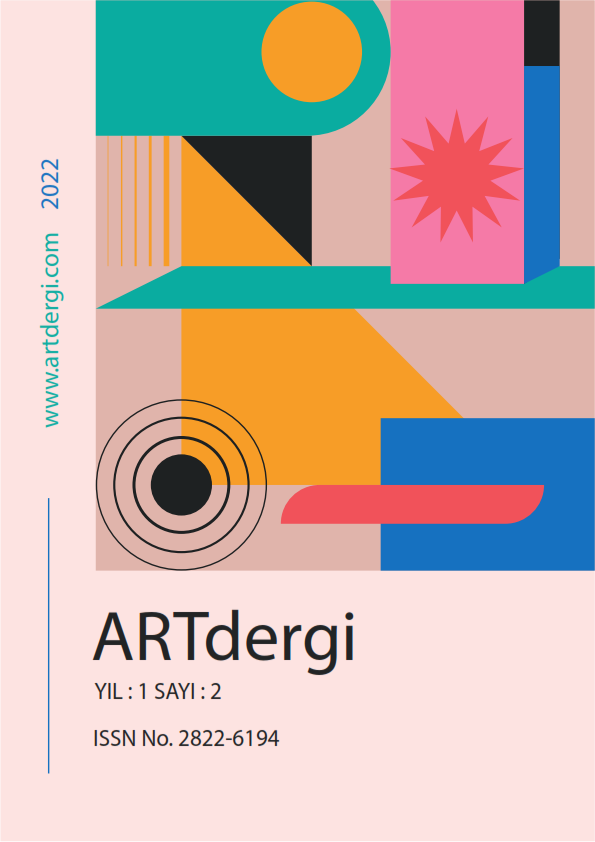IMAGINARY APPROACHES TO WOMEN AND NATURE IN TURKISH CULTURE IN FIGURATIVE CERAMICS
DOI:
https://doi.org/10.5281/zenodo.7566361%20Keywords:
Turkish Culture, Woman and Nature, Figurative of CeramicAbstract
When the historical development of Turkish culture is examined, it is seen that art history data is an important indicator of the society's feelings, thoughts and beliefs in social life. In this context, in order to understand how the subject of women and nature is handled, Turkish art and the visual and literary data of this art are very important in enlightening the subject. When figurative works with women and nature from Central Asia to the present are examined depending on the process in our cultural history, it is seen that the spirit of the period is handled depending on the imagination of the artists in visual and literary arts, especially in religious archeology. The similarity of women's nature to nature such as fertility, nurturing and reproduction throughout the ages is one of the reasons why women's identity is associated with nature and used as a beloved figure in all areas of life and art. Ceramic, which takes its source from nature, has not only been the subject of pottery production with the possibilities offered by its material, but has also enriched its artistic figurative perspective over time. When evaluated from this point of view, the figures that embody the social changes and developments in their period are, in a way, historical documents of ceramic art in terms of their periodicity and techniques. Especially in the Republican period, the perspective brought by the artists who went abroad to reflect the movements they were affected by on their return home, over time destroyed the traditional interpretations and allowed the diversification of figurative works. Thus, more contemporary and original works emerged. Therefore, the woman element, as a popular element in every period of Turkish culture, has been included in nature. With this study, which aims to create a resource for future researchers by considering the subject of woman and nature, which allows the diversification of figurative works, it is seen that the subject of women and nature, which is the source of inspiration for the figurative ceramics of local and foreign artists, is an important tool for these artists to express themselves through imaginary expressions. .References
Kuyucuoğlu İ, Batı’da Din Sosyolojisi Teori ve Yöntem Analizleri, Eskiyeni Yayınları, 2004.
Kuşcan, Ö. A, Lilith’den Malala’ya Kadının Adı Var, İstanbul, Türkiye, Puslu Yayınları, 2015.
Kaytan, E. Modern Sanatta Figüratif Seramik Heykeller, Dokuz Eylül Üniversitesi Güzel Sanatlar Enstitüsü Seramik Anasanat Dalı Yüksek Lisans Tezi, 2009.
Uludağ, FM, Türk Mitolojisinde Hayat Ağacı (Kayın ağacının) Çağdaş Seramik Sanatında Figüratif Yorumu, Gazi Üniversitesi Güzel Sanatlar Enstitüsü Yüksek Lisans Tezi, 2017.
Çağlıtütüncigil, E, Türk Süsleme Sanatında Nar: “Form, Kö-ken ve İkonografik Anlamı”, Türklük Bilimi Araştırmaları Dergisi, 2013.
Arık R, Anadolu Türk devri Çini ve Seramik Sanatı, İstanbul, Türkiye, 2007, Kültür ve Turizm Bakanlığı Yayınları
Arcasoy, A, Seramik Teknolojisi, Marmara Üniverstesi Güzel Sanatlar Fakültesi Yayınları, İstanbul, Türkiye, 1983.
Uğur, B, Çağdaş Türk Seramik Sanatındaki Figüratif Eğilimlerin Plastik Açıdan İncelenmesi, İnönü Üniversitesi Yüksek Lisans Tezi, 2019.
Meriç, F, Çağdaş Türk Seramik Sanatında Figür ve Kişisel Öneriler, Marmara Üniverssitesi Sosyal Bilimler Enstitüsü Seramik ve Cam Dalı Yüksek Lisans Tezi, 1994.
Korkmaz, T, Ymenicioğlu, E, Bedri Rahmi Eyüpoğlu ve Resim Yüzeyi Olarak Seramik Malzeme, Ulakbilge Sosyal Bilimler Dergisi, 2019.
Downloads
Published
How to Cite
Issue
Section
License
Copyright (c) 2023 International Journal of Art, Fashion, Music and Design

This work is licensed under a Creative Commons Attribution-NonCommercial 4.0 International License.


